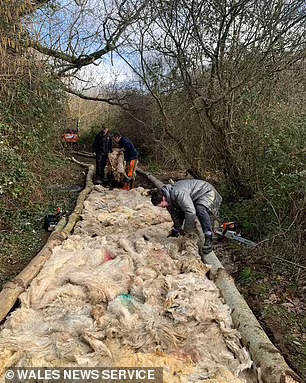“With an increased awareness of environmental and climate issues, we urgently need to look at new ways of using natural materials such as wool to create sustainable products.” [Made with Wool]
.
The Sid Valley produces wool: Sheep farming in the Sid Valley – Vision Group for Sidmouth
And its products are very useful: The science of keeping warm by putting on a jumper – Vision Group for Sidmouth
However, the wool industry has been in slow decline for some time now: Why demand for British wool is unravelling – BBC News
And yet, all sorts of innovative ways to make use of wool are being put forward – with a couple of examples from Wales:
Tasked by a Welsh Government funded project ‘Made with Wool’, Product Design students at Bangor University accepted their challenge to create innovative products using Welsh Wool which included mountain bike mudguards, surfboard fins and fruit bowls.
Elen Parry, Made with Wool project manager, said, “The cost of sheering has been higher than the price farmers get for fleece for some time. With an increased awareness of environmental and climate issues, we urgently need to look at new ways of using natural materials such as wool to create sustainable products. Bangor Product Design students have come up with ingenious ideas which will showcase Welsh wool as a diverse and sustainable biproduct which can be developed to meet future commercial production needs.”
Welsh wool being combined with seaweed to create compostable plastic alternative

Sheep’s wool is being turned into footpaths and laid across boggy areas of the countryside to help walkers cross wet land. Fleeces are being used on damaged footpaths after a woolly initiative to provide a sustainable alternative to using plastics on Anglesey, in North Wales. It is hoped the project will make use of fibers that have lost its radiance in recent times and will also help farmers to dispose of their sheep’ fleeces after the value of wool fell dramatically in recent years.
The sceheme hopes the use of fleeces will become the norm as an eco-friendly substitute for the synthetic membranes normally used to underlay paths before they are covered by aggregates and stones. Elen added: ‘Although the use of sheep wool is an old technique, historically used to repair paths, it remains relatively unused in contemporary construction.’ The technique of sheep’s fleece paving dates back to the Roman Empire, when fleeces were used to create protective layers on waterlogged ground on new roads that were being built.
Finally, it does indeed seem to be the perfect ‘sustainable’ material:
As the concern of how plastic and synthetic materials has on the environment continues to grow. Could the use of natural fibres – such as wool – reduce this impact? Why wool is the best choice for the environment | British Wool
Wool has long been accepted as an environmentally positive fibre choice with a number of benefits, such as being 100% natural, renewable, biodegradable and recyclable. Not to mention that it is thermo-regulating, easy to care for, and can be repaired and enjoyed for years and years. Sustainable Fibres – Wool As A Sustainable Fibre | Woolmark
Sheep Inc, which claims to be the world’s first “carbon negative” fashion brand. The London-based brand factors farming (including methane, sheep farming’s main source of emissions), manufacturing, packaging and transport into its analysis, according to a report from independent certifiers, Carbon Footprint. Can regenerative wool make fashion more sustainable? – BBC Future